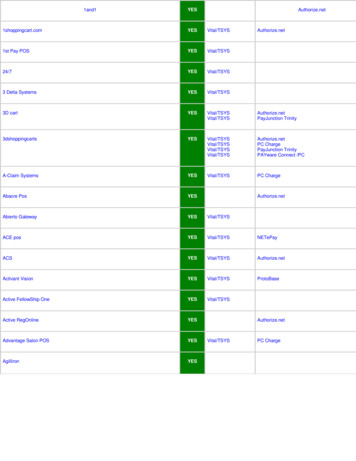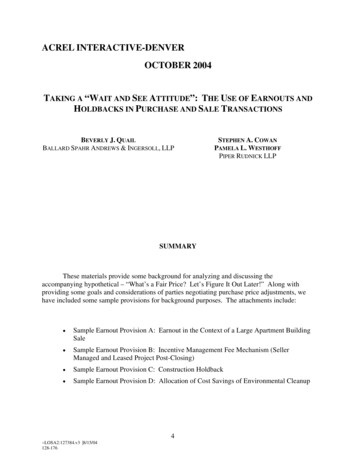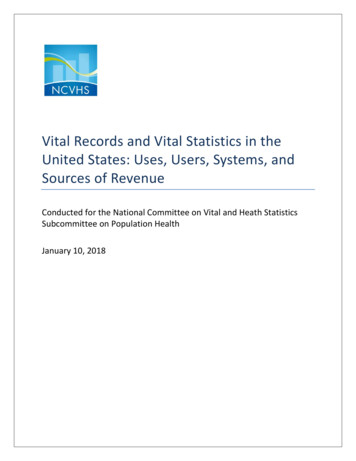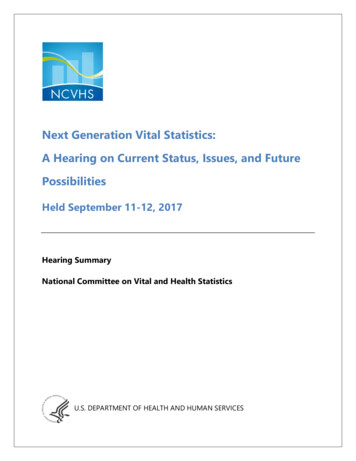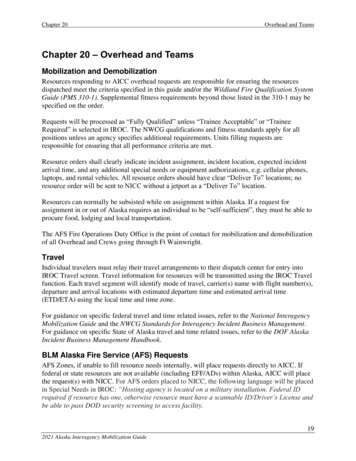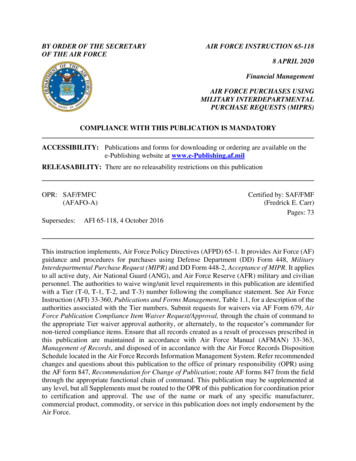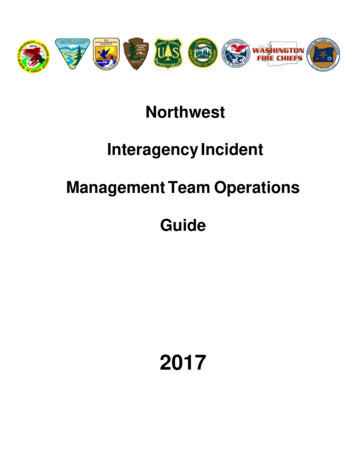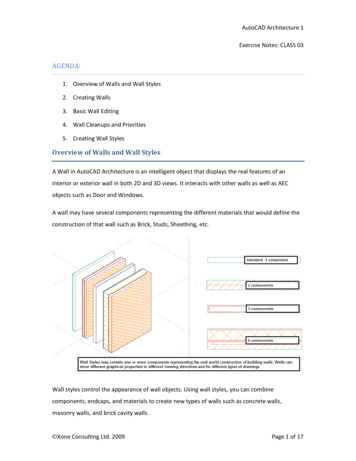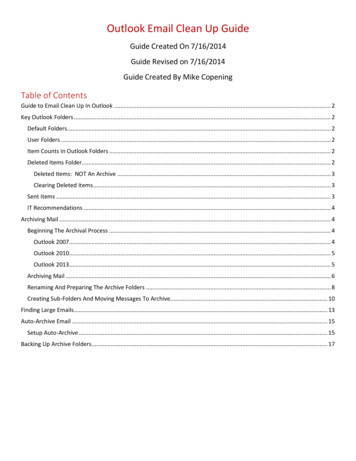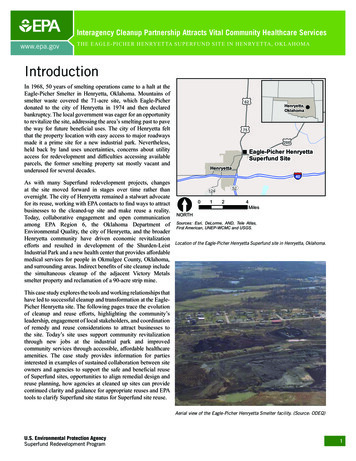
Transcription
Interagency Cleanup Partnership Attracts Vital Community Healthcare Serviceswww.epa.govTHE EAGLE-PICHER HENRYETTA SUPERFUND SITE IN HENRYETTA, OKLAHOMAIntroductionIn 1968, 50 years of smelting operations came to a halt at theEagle-Picher Smelter in Henryetta, Oklahoma. Mountains ofsmelter waste covered the 71-acre site, which Eagle-Picherdonated to the city of Henryetta in 1974 and then declaredbankruptcy. The local government was eager for an opportunityto revitalize the site, addressing the area’s smelting past to pavethe way for future beneficial uses. The city of Henryetta feltthat the property location with easy access to major roadwaysmade it a prime site for a new industrial park. Nevertheless,held back by land uses uncertainties, concerns about utilityaccess for redevelopment and difficulties accessing availableparcels, the former smelting property sat mostly vacant andunderused for several decades.As with many Superfund redevelopment projects, changesat the site moved forward in stages over time rather thanovernight. The city of Henryetta remained a stalwart advocatefor its reuse, working with EPA contacts to find ways to attractbusinesses to the cleaned-up site and make reuse a reality.Today, collaborative engagement and open communicationamong EPA Region 6, the Oklahoma Department ofEnvironmental Quality, the city of Henryetta, and the broaderHenryetta community have driven economic revitalizationefforts and resulted in development of the Shurden-LeistIndustrial Park and a new health center that provides affordablemedical services for people in Okmulgee County, Oklahoma,and surrounding areas. Indirect benefits of site cleanup includethe simultaneous cleanup of the adjacent Victory Metalssmelter property and reclamation of a 90-acre strip mine. 62Henryetta,Oklahoma52UV! 75 266" Eagle-Picher HenryettaSuperfund SiteHenryetta§ 4052VU124VU[0124MilesNORTHSources: Esri, DeLorme, AND, Tele Atlas,First American, UNEP-WCMC and USGS.Location of the Eagle-Picher Henryetta Superfund site in Henryetta, Oklahoma.This case study explores the tools and working relationships thathave led to successful cleanup and transformation at the EaglePicher Henryetta site. The following pages trace the evolutionof cleanup and reuse efforts, highlighting the community’sleadership, engagement of local stakeholders, and coordinationof remedy and reuse considerations to attract businesses tothe site. Today’s site uses support community revitalizationthrough new jobs at the industrial park and improvedcommunity services through accessible, affordable healthcareamenities. The case study provides information for partiesinterested in examples of sustained collaboration between siteowners and agencies to support the safe and beneficial reuseof Superfund sites, opportunities to align remedial design andreuse planning, how agencies at cleaned up sites can providecontinued clarity and guidance for appropriate reuses and EPAtools to clarify Superfund site status for Superfund site reuse.Aerial view of the Eagle-Picher Henryetta Smelter facility. (Source: ODEQ)U.S. Environmental Protection AgencySuperfund Redevelopment Program1
Site History, Contamination and RemediationFrom 1916 to 1968, the Eagle-Picher Mining and Smelting Company (now Eagle-Picher Industries) operated ahorizontal retort smelter for roasting, sintering and recovery of zinc, cadmium and germanium on site. In the mid1950s, the smelter was reportedly the world’s second largest horizontal retort primary zinc smelter, with a furnacecapacity of 8,000 retorts. The facility recovered metals from ores from locations across the Tri-State Mining Districtof northeast Oklahoma, southeast Kansas and southwest Missouri.The smelter closed down in 1968 and the company donated the 71-acre property to the city of Henryetta in 1974.Eagle-Picher Industries demolished most of the production buildings at the site before declaring bankruptcy.However, slag and cinder piles from smelting operations remained. Wind-dispersed dust containing heavy metalskilled area vegetation. Stormwater runoff leached contaminants from waste into the Coal Creek watershed.Between 1974 and 1995, the city – unaware of the metal contamination in the waste piles – used soil from the siteas fill material at neighborhoods, schools and parks across the community. While the city never operated on thesite property, it leased parts of the site to four companies in 1975. The city also unknowingly spread contaminationfrom the site. As a result, the city became a potentially responsible party (PRP) and settled with EPA and ODEQ tocleanup the site.EPA and Oklahoma state agencies led several site investigations in the 1980s. A 1988 EPA site assessment concludedthat contaminant levels in waste on site did not present an unacceptable risk to human health and the environmentat that time. Later, when the lead health standards were changed, ODEQ requested EPA assistance at the site todetermine its protectiveness with the new, lower standards. EPA concluded that contamination at the site now posedan imminent risk to human health and the environment and contaminant migration to nearby properties had alreadybeen confirmed. ODEQ also confirmed that wastes used as fill material throughout the city were in high-access areassuch as residential driveways, schools and alleys, posing potential health risks to children and adults.Taking community priorities into account, EPA selected a site cleanup plan in 1996 that would be compatiblewith industrial land uses. EPA implemented the 8.5 million removal action under the authority of the Superfundprogram. EPA signed a cleanup agreement with ODEQ establishing agency roles and responsibilities in August1996. EPA agreed to lead waste excavation, consolidation and capping efforts. ODEQ would lead the establishmentof vegetation to minimize erosion in capped areas and provide an 18 percent reimbursement for EPA cleanup costs.Cleanup included excavation of contaminated material at three public parks, three schools and 162 residentialproperties. EPA contractors brought excavated waste materials to the site for consolidation and encapsulation.When additional off-site contamination areas, including the adjacent, former Victory Metals smelter property, wereidentified during the cleanup, waste materials from these areas were brought on site, consolidated with site wastesand capped on site.Historical images showing the Eagle-Picher Smelter’s operations at the site, 1910s and 1940s. (Source: ODEQ)2
Site History, Contamination and Remediation (continued)EPA staged waste in the 26-acre Central Plateau area of the site prior to consolidation and capping to the north ofthe Central Plateau. The wastes were then capped with a clay cap and soil cover. Materials brought from off-sitelocations had significantly lower contaminant concentrations and provided a better vegetative growth base. Thismaterial was used in the upper 12 inches of subgrade, providing an additional buffer layer over onsite waste materialand the site was brought to grade with a minimum of another 12 inches of clean fill. Contouring and grading designsestablished proper drainage. A 6.5-acre consolidated waste area is located to the north of the Central Plateau. Thisarea is unsuitable for future construction development because of the highly contaminated materials buried there.EPA completed cleanup actions in 1997. ODEQ finished establishing the capped area’s vegetative cover in 1998.Slag piles and smelter wastes prior to cleanup. (Sources: EPA and ODEQ)In 2000, the city of Henryetta entered into an agreement with EPA and ODEQ to conduct long-term maintenanceof the site remedy. The agreement also protects the city, a potentially responsible party at the site, from liabilityfor response costs and third-party contribution claims. Current site uses include a family healthcare facility, aconstruction company and recreational use by an Academy of Model Aeronautics radio control airplane club.Slag pile cleanup on site. (Source: ODEQ)3
ProjectHistorySite Timeline41995 – 1997A Collaborative Vision for Cleanup1916Zinc, cadmium, lead and germanium production operations began.1968Smelting operations ended.1974Eagle-Picher donated 70-acre site property to city of Henryetta.1974-1995City of Henryetta used soil from site as fill material throughout community,including for homes, schools and parks.1975City of Henryetta began leasing parts of property to four companies.1988Based on available lead exposure and risk data, EPA site assessment concludedthat contamination did not present unacceptable risk and no further action wasnecessary.July - August1995EPA began site investigations.December1995EPA performed additional sampling at Wilson and Henryetta Townsite additionsas well as driveways, parks, schools and Central Plateau area.1996City of Henryetta received state and federal grants and completed constructionof the Shurden-Leist Industrial Park in 1996.April 1996Changes to lead exposure and risk data resulted in finding of imminentendangerment. EPA completed streamlined risk evaluation.August 1996EPA began removal actions.August 1996EPA placed gravel-pad parking area and office trailers on Central Plateau areafor staging waste prior to consolidation and capping on 6.5-acre area to thenorth.October 1996Residential excavations began in Henryetta. Contaminated material fromresidential excavations stockpiled at Central Plateau area.
February 1997Remediation of former smelter facility, including the Central Plateau area,underway.March 1997Drainage systems installed in Central Plateau area.July 1997Bermuda grass installation began on Central Plateau area.August 1997Remediation of former smelter facility completed. Cleanup included creationof consolidated waste area, recontouring of site wastes, placement of covermaterial and site revegetation.August 2000U.S. Department of Justice approved Administrative Order on Consentbetween EPA, ODEQ and the city of Henryetta to preserve EPA and ODEQ’sright of access, provide notice of the cleanup to the public, and clarify siteresponsibilities.January 2001City of Henryetta signed Notice of Deed Restriction and planned installation ofclean utility corridors for the Shurden-Leist Industrial Park.May 2006First business – ProStreet Framework – located at Shurden-LeistIndustrial Park.May 2008Shurden-Leist Industrial Park won 2007 Phoenix Award for Region 6.March 2015ECOFHC requested comfort letter from EPA to support its health centergrant application.May 2015EPA and ODEQ jointly issued RfR Determination for site’s Central Plateauarea.May 2016U.S. Department of Health and Human Services awarded ECOFHC a 1million grant to help fund development of health care facility on site.October 2018EPA Region 6 and ODEQ presented ECOFHC with its Excellence in Site ReuseAward at opening of health care facility on site.Looking Forward5
EPA began site investigations in July 1995 and completed astreamlined risk evaluation for the site in April 1996. Duringthe evaluation of remedial alternatives for the site, EPAconsulted with the city of Henryetta about its reasonablyanticipated future use. The city indicated that the industriallyzoned property would hopefully be able to support newindustrial uses following cleanup, recognizing its ideal locationnear U.S. Highway 75 and Interstate 40. For its part, the cityproceeded with state and federal grant applications to fund theproject.Removal actions began in 1996, which addressed residential andhigh-access areas first to minimize the potential for exposureto heavy metals in the community. Remedial contractorsstockpiled materials at the site, then began remediation of theformer smelter property itself in 1997. City officials kept inclose contact with EPA and ODEQ during the cleanup, and alsoreached out to potential private- and public-sector partners tosupport the site’s potential future industrial use.At ODEQ’s request, EPA evaluated and ultimately includedconsolidation of waste materials from the adjacent VictoryMetals smelter property with the consolidated waste from theEagle-Picher Henryetta site. Because the cleanup approach andcontaminants were the same, both areas could be addressedsimultaneously, optimizing resources and mobilization forcleanup. Area businesses and property owners also pitchedin to assist with cleanup efforts that would pave the way forfuture use. For example, a local glass manufacturing companydonated clay from its property for the site’s capped area,creating an impermeable layer over waste at the site. Thisminimized the potential for rainwater infiltration as well ascontaminant leaching and migration. Hamilton strip mine, aclosed former coal mine, donated soil from piles of overburdenon its property for the soil cover above the clay cap and acrossthe entire site. Knowing that the city intended to use theproperty for industrial use, EPA contoured and graded wastematerials prior to placement of the clay cap and the soil coverthat leveled the site. Future industrial park tenants could thenbuild on concrete pad foundations on top of the cap withoutneed to dig into the clean soil cover.The U.S. Bureau of Reclamation’s Technical Service CenterEnvironmental Research Laboratory provided soil sampleanalysis to confirm the acceptability of the topsoil as borrowmaterial. By following a Natural Resource ConservationCommission Plan, donation of overburden also enabled thereclamation of the 90-acre Hamilton strip mine property.The U.S. Department of Agriculture’s Natural ResourcesConservation Service worked with ODEQ and local agenciesto establish a vegetative cover to protect the new cover fromerosion. The city of Tulsa and the city of Okmulgee providedsewer sludge that could be applied as a biosolids treatment forsoil to facilitate establishment of vegetation. ODEQ plantedBermuda grass across the Central Plateau area of the site.6The city of Henryetta secured nearly 500,000 in resourcesto support the development of an industrial park at the site.The city secured funds from both state transportation andenvironmental grants and federal Department of Housing andUrban Development (HUD) and economic development grants.The city completed construction of the Shurden-Leist IndustrialPark, named for former Oklahoma Senator Frank Shurden andRepresentative M.C. Leist who supported the effort, in 1996.CappingCapping involves placing a cover over contaminated materialsuch as landfill waste or contaminated soil. Such covers arecalled “caps.” Caps do not destroy or remove contaminants.Instead, they isolate them and keep them in place to avoid thespread of contamination. Caps prevent people and wildlife“I just see unlimited possibilities, that thecleanup has made this area amazing for thecity to develop.”– Jennifer Munholland, Mayor of Henryettafrom coming in contact with contaminants. The site has twotypes of caps – a clay cap with a soil cover on the CentralPlateau area and an engineered cap encapsulating the wastewith highest contaminant concentrations in the consolidatedwaste area.1998 – 2008Ready and Waiting for ReuseWith completion of Shurden-Leist Industrial Park in 1996, EPAled remedy construction completion in 1997 and vegetationestablished on site, it seemed that all pieces were in place forContouring of site slag piles during cleanup. (Source: ODEQ)
Filling in excavated areas with clean material. (Source: ODEQ)Final site grading. (Source: ODEQ)Cover soil placement. (Source: ODEQ)Aerial view of the final soil cover in place. (Source: ODEQ)Revegetation. (Source: ODEQ)Clay donated by a local glass manufacturer to cap waste on site.(Source: ODEQ)A nearby mining company donated overburden soil from its property touse as part of the site cap. (Source: ODEQ)7
the industrial redevelopment of the site. The cleanup hadbeen completed with industrial reuse in mind. The project hadstrong community buy-in, with local agencies and businessessupporting cleanup and reuse efforts. Funding had been securedfrom state and federal partners backing the project. Despitethese factors, however, the city waited for its first tenant at theindustrial park for a decade.In 2000, EPA, ODEQ and the city of Henryetta entered into anAdministrative Order on Consent to preserve agency access tothe site, provide public notice of the cleanup, and clarify parties’roles and responsibilities moving forward. The city agreed totake on responsibility for maintenance of the site’s remedy andfiled a Notice of Deed Restriction in January 2001. In additionto protecting the site’s remedy, the notice clarified due diligencesteps and restrictions for prospective industrial park tenantsinterested in developing facilities on capped areas at the site.Still the anticipated tenants did not come.restrictions prohibited disturbance of the cap, which limitedinstallation of underground utilities. ODEQ provided guidanceon a way to install clean utility corridors. With appropriateoversight and controls, an area of the protective cover andwaste could be excavated, leaving clean conduits for runningutilities that would not require digging through waste materials.Clean fill and reestablishment of the cover by the city left theremedy intact and industrial park lots “pad ready” for tenantdevelopment. The city also extended an industrial access roadto the entrance of the industrial park to facilitate truck andmachinery deliveries.In May 2006, ProStreet Framework, a motorcycle manufacturingfacility, signed on as the first tenant at Shurden-Leist IndustrialPark. The industrial park went on to receive the 2007 PhoenixAward for redevelopment success in EPA’s South-CentralRegion.Concerned by the sustained lack of interest in the property,Henryetta’s Economic Development Authority reached out toODEQ, which was responsible for oversight of site developmentand maintenance activities that might impact the cleanup. Themain concerns raised by prospective tenants were insufficientutility services and access limitations. The 2001 land useImproved access roads and clean utility corridors attracted Shurden-Leist Industrial Park’s first tenant in 2006. (Source: EPA)8
75s trial Boulevardurd enInduSEas t0250h500East Central OklahomaFamily Health Center1,000FeetSource: Esri, DigitalGlobe, GeoEye, EarthstarGeographics, CNES/Airbus DS, USDA, USGS, AEX,Getmapping, Aerogrid, IGN, IGP, swisstopo and theGIS User Community.[NORTHLegendCentral PlateauFormer FacilityEagle-Picher Henryetta Former Smelter FacilityHenryetta, Okmulgee County, Oklahoma9
2015 – 2018Stepping Up to AddressCommunity Healthcare NeedsBy 2015, cleanup had literally paved the way for future useopportunities at the site. EPA and ODEQ cleanup effortswere complete. The city of Henryetta had clarified land userestrictions to support the long-term maintenance of the remedyand its compatibility with site uses. ODEQ continued toprovide oversight and helped address hurdles that had deterredprospective site users, resulting in site access improvementsand utility upgrades by the city. With these key pieces in placeand tenants located at Shurden-Leist Industrial Park, the cityremained focused on recruiting more tenants to fill out theindustrial park. Meanwhile, ODEQ learned that a healthcarefacility was looking for a new location and began introducingthe group to both the city of Henryetta and EPA Region 6 toexplore options.“Not only do we have medical, we have dentaland behavioral health. So, it’s a facility thatis able to take care of all of the needs of thecommunity.”– Donna Dyer, ECOFHC CEOIn March 2015, city manager Ted Graham received a letter fromthe East Central Oklahoma Family Health Center (ECOFHC).The Center was applying for a Health Infrastructure InvestmentProgram (HIIP) grant through the U.S. Health Resources andServices Administration (HRSA) for construction of a healthcenter to provide medical, dental and behavioral health servicesto people in Okmulgee County and surrounding areas. Thecenter would provide primary health care, certified drug testing,immunizations, vaccines, behavioral health, and primary andpreventative dental care for adults and children. As the city hadanticipated for years, the site’s location was a major attraction.“With this proposed site located on the north side of Henryettaon a major highway, easier access [to health services] from thenorth side of Okmulgee County would be available,” ECOFHCCEO Donna Dyer indicated in her letter.Ms. Dyer requested the city’s assistance with ECOFHC’s grantapplication. She asked for a commitment letter indicating thecity’s support for the project and developing a health centeron city-owned property. For the city, the project represented apotential win-win – securing a new tenant for a city propertywhile also supporting the provision of high-quality andcomprehensive health services in a medically underserved area.10EPA and ODEQ reviewed ECOFHC’s request and hosted openhouses at Henryetta City Hall to help clarify the site’s suitabilityfor reuse and address community questions and concerns. Shealso asked the city to coordinate with EPA and ODEQ for agencydocumentation of the site’s history, cleanup and potential for use.EPA also prepared a status, or comfort, letter regarding the site forECOFHC. The letter summarized the site’s history, cleanup andpotential for future use, and shared information about applicableAgency policies or restrictions related to redevelopment. Theletter indicated that the proposed health center did not pose anyincompatibility issues and that communication should remainopen with ODEQ and EPA as development plans proceeded.The letter also shared information about EPA’s bona fideprospective purchaser liability protections and what ECOFHCwould need to do to qualify for these protections. EPA andODEQ also prepared a Ready for Reuse (RfR) Determinationfor the site in support of the proposed health center project. AnRfR Determination is a technical document that provides anenvironmental status summary clarifying if a site, or part of asite, can support specific types of land uses. EPA and ODEQco-issued the RfR Determination for the site’s Central Plateauarea in May 2015. It indicated that the area could be used forindustrial and commercial purposes, including a health center.With its application strengthened by the RfR Determination andthe city of Henryetta’s commitment to the project, ECOFHCreceived a 1 million construction grant from HRSA’s HIIPprogram in May 2016.1 The organization worked closely withEPA and ODEQ on the health center’s construction to ensure“EPA, ODEQ, and the city of Henryetta haveworked for many years to transform this sitefrom a burden on the community into an assetfor the whole region. Because of these efforts,today we can celebrate yet another formerlycontaminated property being brought back intoeconomic use, with the people of Henryettaand surrounding communities benefitting foryears to come.”– Anne Idsal,Former EPA Region 6 Regional Administrator1 This project is supported by the Health Resources and ServicesAdministration (HRSA) of the U.S. Department of Health and HumanServices (HHS) under C8DCS29734, Health Infrastructure InvestmentProgram in the amount of 1,000,000, 24.46% of this project is fundedthrough non-federal and local resources. This information or contentand conclusions are those of the author and should not be construedas the official position or policy of, nor should any endorsementsbe inferred by HRSA, HHS or the U.S. Government. The totalapproximate cost for this project is 1.7 million.
“During the Health Infrastructure InvestmentProgram grant application process, ECOFamily Health Center was able to coordinatewith the city of Henryetta, EPA and ODEQto meet the needs of the community in alocation that at one time was unusable.The former Eagle-Picher zinc smelter sitein Henryetta was the perfect location toprovide medical, dental and behavioralhealth services to Okmulgee County.”– Donna Dyer, ECOFHC CEOECOFHC’s new health-care facility officially opened to the public inOctober 2018. (Source: EPA)the protectiveness of EPA’s remedy. Regular coordination phonecalls and site visits kept all parties on the same page and alloweda venue for ODEQ and EPA to provide feedback on constructionplans.In October 2018, ECOFHC opened its doors to the community,offering comprehensive health services in a readily accessiblelocation. At the facility’s opening, EPA Region 6 presentedECOFHC and the city of Henryetta with Excellence in SiteReuse awards for their dedication to ensuring the safe andappropriate use of the site in a way that also serves the broadercommunity.“The restoration and redevelopment ofthis property has turned it into an asset forHenryetta and the surrounding communities,and all of us at ODEQ are proud of what hasbeen accomplished.”ECOFHC offers medical, dental and behavioral health services to areacommunities. (Source: EPA)“Our mission is to provide affordable, highquality, patient-centered health care for eastcentral Oklahoma.”– Scott Thompson, ODEQ Executive Director– EPA SRP Site Redevelopment ProfileThe October 2018 ribbon-cutting ceremony for the ECOFHC facility. (Source: EPA)11
EPA Region 6 Excellence in Site Reuse AwardEPA’s South-Central Region established the Excellence in Site Reuse Award to recognize parties that have supported thereuse of Superfund sites through outstanding efforts that go above and beyond required cleanup. The award can be given to aresponsible party, developer, site owner, nonprofit, local government, community member or other key stakeholder who hasdemonstrated excellence in working cooperatively with Region 6. Superfund reuse should complement cleanup and may playa key role in ensuring the remedy is protective in the future.Award Evaluation Criteria1. Consideration of and effect on the local community.2. Implementation of sustainable practices.3. Innovation and creative thinking.4. Consideration of long-term implementation of theselected remedy and its impact on the environment.5. Demonstration of outstandingenvironmental stewardship.EPA staff and award recipients celebrate ECOFHC’s opening in October 2018. From left to right: Erin Chancellor, EPA Region 6 Chief ofStaff; Ken Wagner, Senior Advisor for the EPA Administrator; Anne Idsal, former Region 6 Regional Administrator; Donna Dyer, CEO EastCentral Oklahoma Family Health Center; Jennifer Munholland, Mayor of Henryetta, Oklahoma; and Casey Luckett, Region 6 SuperfundRedevelopment Coordinator.Lessons LearnedThe working relationship between EPA, ODEQ and the cityof Henryetta has played a pivotal role in the site’s cleanupand reuse. It has fostered open communication among keystakeholders, allowing EPA to design and implement a remedythat protects public health and the environment while alsolaying the groundwork for compatible future use opportunitiesprioritized by the community. The city of Henryetta engaged early in the Superfundprocess, indicating interest in the future industrial use ofthe property, which helped inform site agencies’ cleanupplanning and design. Sustained long-term coordination between site agenciesand the city meant that all parties could discuss challengesand issues over time, such as when the industrial parkstruggled to land its first tenant. Henryetta’s Economic Development Authority primed thesite for redevelopment and then spent a decade workingwith city leaders and regulatory agencies exploring waysto market the property in a way that would bring intenants. Instead of issuing a blanket “no” for site improvements,ODEQ staff sat down with city officials to identifyopportunities for site access and the extension ofunderground utilities across the site without impactingthe site’s remedy.12 When ECOFHC approached the city about needinginformation resources to help support its grant proposal,the city provided a commitment letter and EPA and ODEQresponded rapidly with an RfR Determination that clearlylaid out the site’s history, remedial status and capacity tosupport land uses that aligned with ECOFHC’s proposal.This status report was a vital piece of information aidingECOFHC’s grant application that ultimately led to thesuccessful funding and construction of the health centeron site.Bigger PictureIn addition to the site-specific lessons above, a range ofbroader lessons learned can also help guide similar projects atcontaminated lands across the country.Local governments play a key leadership role in cleanupand redevelopment projects.As a potentially responsible party at the site as well as an advocatefor long-term community priorities, the city of Henryetta wasuniquely positioned to support the site’s transition from its smelterpast into a revitalized future. The city engaged early in the Superfundprocess, working with site agencies to discuss the possibility offuture industrial development at the site. It also worked with localbusinesses to rally support and resources for cap construction andworked with EPA and ODEQ on options for better positioning theproperty for market, eventually launching an industrial park andthen supporting the development of a community health center.
Community partners can bring resources to the table tosupport the remedy and the reuse of a contaminated site.Henryetta officials worked with local businesses to secure clayand clean soil fill material to contour, grade and level out thesite property under a minimum 12-inch soil cover. A local glassmanufacturing company donated clay from its property forthe impermeable surface cap placed over consolidated waste.Overburden soils at the former Hamilton strip mine providedsoil cover for the entire site.Inter-agency project coordination can result in resourceoptimization.Implementation of the remedy was actually a cleanup three-forone thanks to coordination among various agency stakeholders.During remedial investigations, ODEQ noted similarcontamination at the former Victory Meta
From 1916 to 1968, the Eagle-Picher Mining and Smelting Company (now Eagle-Picher Industries) operated a horizontal retort smelter for roasting, sintering and recovery of zinc, cadmium and germanium on site. In the mid-1950s, the smelter was reportedly the world's second largest horizontal retort primary zinc smelter, with a furnace

